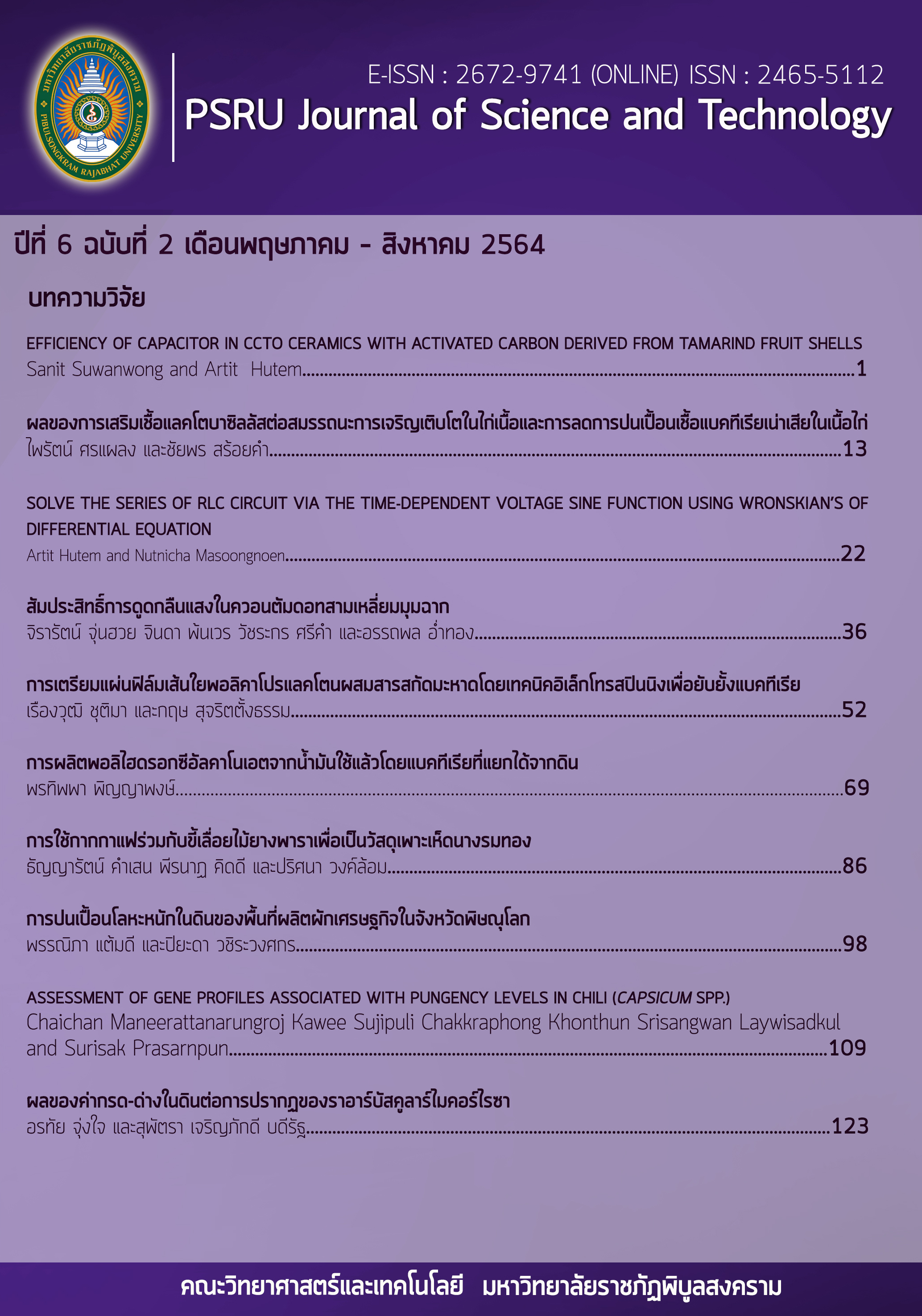THE PREPARATION OF POLYCAPROLACTONE FIBERS FILM CONTAINING ARTOCARPUS LAKOOCHA EXTRACT BY ELECTROSPINNING TECHNIQUE FOR ANTIBACTERIAL ACTIVITIES
Keywords:
Electrospinning, Nanofiber, A. lakoocha extract, Antibacterial activityAbstract
This research, the polycaprolactone fibers containing A. lakoocha extract were prepared by electrospinning technique. The optimum condition for fibers formation was investigated and tested for the antibacterial activity. The results showed that the optimum condition of polycaprolactone fibers was 16 w/v% of polycaprolactone solution. The electrospinning conditions were as follows; the diameter of metallic needle was 0.8 mm, the distance between the needle tips to the collector was 20 cm and the electric field was 90 kV/m.
The results of the A. lakoocha extraction were found that, the %yield of 5.3 by weight. Minimum Inhibitory Concentration (MIC) of A. lakoocha crude extract was in the range of 3.12–6.25 mg/ml. After preparation of polycaprolactone fibers with the A. lakoocha extract, the viscosity of the polymer solution was increased with increasing the concentration of the A. lakoocha extract. For the antibacterial tests by disc diffusion method, the polycaprolactone fiber with the A. lakoocha extract were tested against Bacillus subtilis (B. subtilis), Staphylococcus aureus (S. aureus) and Escherichia coli (E. coli). The antibacterial activity of polycaprolactone fiber with the A. lakoocha extract at 8.0 w/V% indicated that the inhibition zone was 12.0±0.05 mm and 9.2±0.10 mm against B. subtilis and S. aureus, and the inhibition zone was not found after testing with E. coli. Respectively. From the properties of the polycaprolactone fiber film prepared by the electrospinning technique and the antibacterial properties of the A. lakoocha extract, the fibrous film could be developed to use as a wound dressing for prevent infection in wound.
References
คคนางค์ รัตนานิคม, นิคม ศรีกะชา, และยุภาพร ขันนาเลา. (2562). ฤทธิ์การยับยั้งการเจริญของเชื้อแบคทีเรียก่อโรคในมนุษย์ของสารสกัดมะหาด. วารสารการแพทย์แผนไทยและการแพทย์ทางเลือก, 17(1), 54-62.
สุดารัตน์ หอมหวล. (2553). ฐานข้อมูลสมุนไพร คณะเภสัชศาสตร์ มหาวิทยาลัยอุบลราชธานี. สืบค้นเมื่อ 23 มีนาคม 2559, จาก http://www.phargarden.com/main.php.
อรพิณ โกมุติบาล, กัลยาภรณ์ จันตรี, อัยลดา เกตุแก้ว, และจณิสตา ใจสมุทร. (2561). ฤทธิ์การยับยั้งแบคทีเรียที่ก่อให้เกิดสิว (Propionibacterium acnes) ของสารทรานส์-ออกซิเรสเวอราทรอล และเรสรอซินอลจากแก่นมะหาด. Advanced Science, 17, 99-113.
Agarwal, S., Wendorff, J.H., & Greiner, A. (2008). Use of electrospinning technique for biomedical applications. Polymer, 49, 5603-5621.
Alves de Castro, P., Bom, V.L.P., Brown, N.A., Couto de Almeida, R.S., Ramalho, L.N.Z., Savoldi, M., Goldman, M.H.S., Berretta, A.A., & Goldman G.H. (2013). Identification of the cell targets important for propolis-induced cell death in Candida albicans. Fungal Genetics and Biology, 60, 74–86.
Bankova, V., Galabov, A.S., Antonova, D., Vilhelmova, N., & Di Perri, B. (2014). Chemical composition of Propolis Extract ACF® and activity against herpes simplex virus. Phytomedicine, 21, 1432–1438.
Bhardwaj N., Kundu S.C. (2010). Electrospinning: A fascinating fiber fabrication technique. Biotechnology Advances, 28, 325–347.
Dalton, P.D., Grafahrend, D., Klinkhammer, K., Klee, D., & Moller, M. (2007). Electrospinning of polymer melts: Phenomenological observations. Polymer, 48, 6823-6833.
Essalhi, M., & Khayet, M. (2014). Self-sustained webs of polyvinylidene fluoride electrospun nano-fibers: effects of polymer concentration and desalination by direct contact membrane distillation. Journal of Membrane Science, 454, 133-143.
Gaumer, J., Prasad, A., Lee, D., & Lannutti, J. (2009). Structure–function relationships and source-to-ground distance in electrospun polycaprolactone. Acta Biomaterialia, 5, 1552-1561.
Ghasemi-Mobarakeh, L., Prabhakaran, M.P., Morshed, M., Nasr-Esfahani, M.H., & Ramakrishna, S. (2010). Bio-functionalized PCL nanofibrous scaffolds for nerve tissue engineering. Materials Science and Engineering C, 30, 1129-1136.
Han, J., Branford-White, C.J., & Zhu, L.M. (2010). Preparation of poly(ε-caprolactone)/poly(trimethylene carbonate) blend nanofibers by electrospinning. Carbohydrate Polymers, 79, 214-218.
Huang, Z.M., Zhang, Y.Z., Ramakrishan, S., & Lim, C.T. (2004). Electrospinning and mechanical characterization of gelatin nanofibers. Polymer, 45, 5361-5368.
Jagtap, B., & Bapat, V.A. (2010). Artocarpus: A review of its traditional uses, phytochemistry and pharmacology. Journal of Ethnopharmacology. 129, 142–166.
Jia B., Zhou J., & Zhang L. (2011). Electrospun nano-fiber mats containing cationic cellulose derivatives and poly (vinyl alcohol) with antibacterial activity. Carbohydrate Research, 346, 1337-1341.
Kaewkod, T., Tragoolpua, K., & Tragoolpua, Y. (2016). Encapsulation of artocarpus lacucha Roxb. extract in alginate chitosan nanoparticles for inhibition of Methicillin Resistant Staphylococcus aureus and Bacteria causing skin diseases. Chiang Mai Journal of Science, 43(5), 946-958.
Kenawy, E.R., Abdel-Hay, F.I., El-Newehy, M.H., & Wnek. G.E. (2009). Processing of polymer nanofibers thrugh electrospinning as drug delivery systems. Materials Chemistry and Physics, 113, 296-302.
Lee, K.Y., Jeong, L., Kang, Y.O., Lee, S.J., & Park, W.H. (2009). Electrospinning of polysaccharides for regenerative medicine. Advanced Drug Delivery Review, 61, 1020-1032.
Li, D., & Xia, Y. (2004). Electrospinning of nanofibers: reinventing the wheel. Advance Materials, 16, 1151-1169.
Maneechai S., De-Eknamkul W., Umehara K., Noguchi H., & Likhitwitayawuid K. (2012). Flavonoid and stilbenoid production in callus cultures of Artocarpus lakoocha. Phytochemistry, 81, 42–49.
Potkonjak, N.I., Dragan, V.S., Novakovic, M.M., Gorjanovic, S.Z., Pezo, L.L., & Suznjevic, D.Z. (2012). Antioxidant activity of propolis extracts from Serbia: A polarographic approach. Food and Chemical Toxicology, 50, 3614–3618.
Prabhakaran, M.P., Venugopal, J., & Ramakrishna, S. (2009). Electrospun nanostructure scaffolds for bone tissue engineering. Acta Biomaterialia, 5, 2884-2893.
Santos, F.A., Bastos, E.M.A., Uzeda, M., Carvalho, M.A.R., Farias, L.M., Moreira, E.S.A., & Braga, F.C. (2002). Antibacterial activity of Brazilian propolis and fractions against oral anaerobic bacteria. Journal of Ethnopharmacology, 80, 1-7.
Singhatong S., Leelarungrayub D., & Chaiyasut C. (2010). Antioxidant and toxicity activities of Artocarpus lakoocha Roxb. Heartwood extract. Journal of Medicinal Plants Research, 4(10), 947-953.
Wang, J., Cheung, M.K., & Mi, Y. (2002). Miscibility and morphology in crystalline/amorphous blends of poly(caprolactone)/poly(4-vinylphenol) as studied by DSC, FTIR, and 13C solid state NMR. Polymer, 43,1357-1364.
Yoshimoto, H., Shin, Y.M., Terai, H., & Vacanti, J.P. (2003). A biodegradable nanofiber scaffold by electrospinning and its potential for bone tissue engineering. Biomaterials, 24, 2077-2082.
Downloads
Published
How to Cite
Issue
Section
License
กองบรรณาธิการขอสงวนสิทธิ์ในการปรับปรุงแก้ไขตัวอักษรและคำสะกดต่างๆ ที่ไม่ถูกต้อง และต้นฉบับที่ได้รับการตีพิมพ์ในวารสาร PSRU Journal of Science and Technology ถือเป็นกรรมสิทธิ์ของคณะวิทยาศาสตร์และเทคโนโลยี มหาวิทยาลัยราชภัฏพิบูลสงคราม และ
ผลการพิจารณาคัดเลือกบทความตีพิมพ์ในวารสารให้ถือมติของกองบรรณาธิการเป็นที่สิ้นสุด







